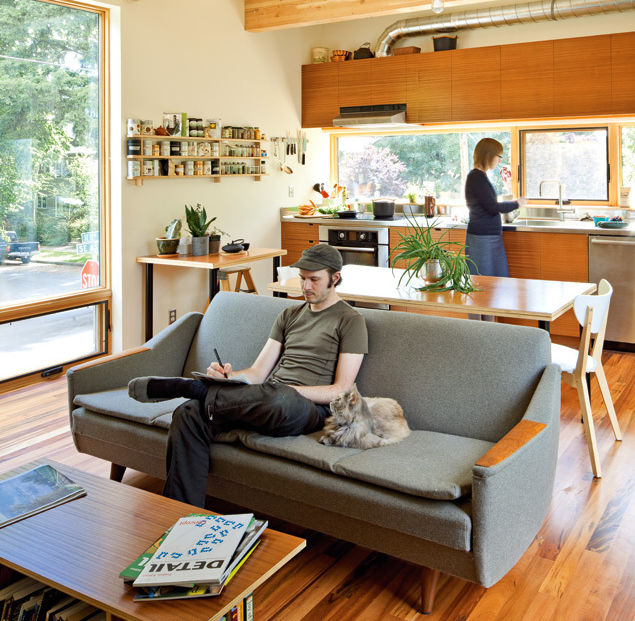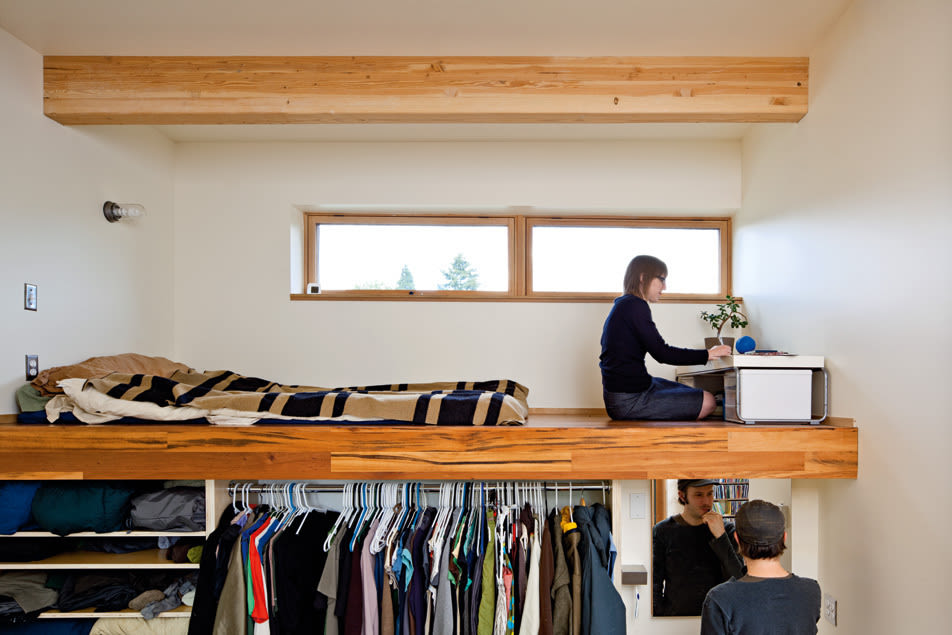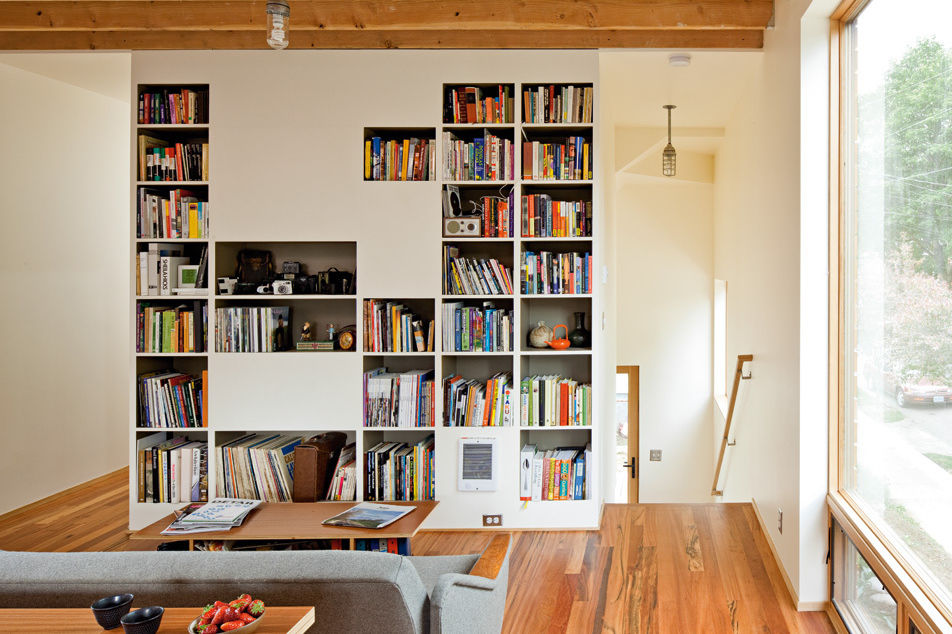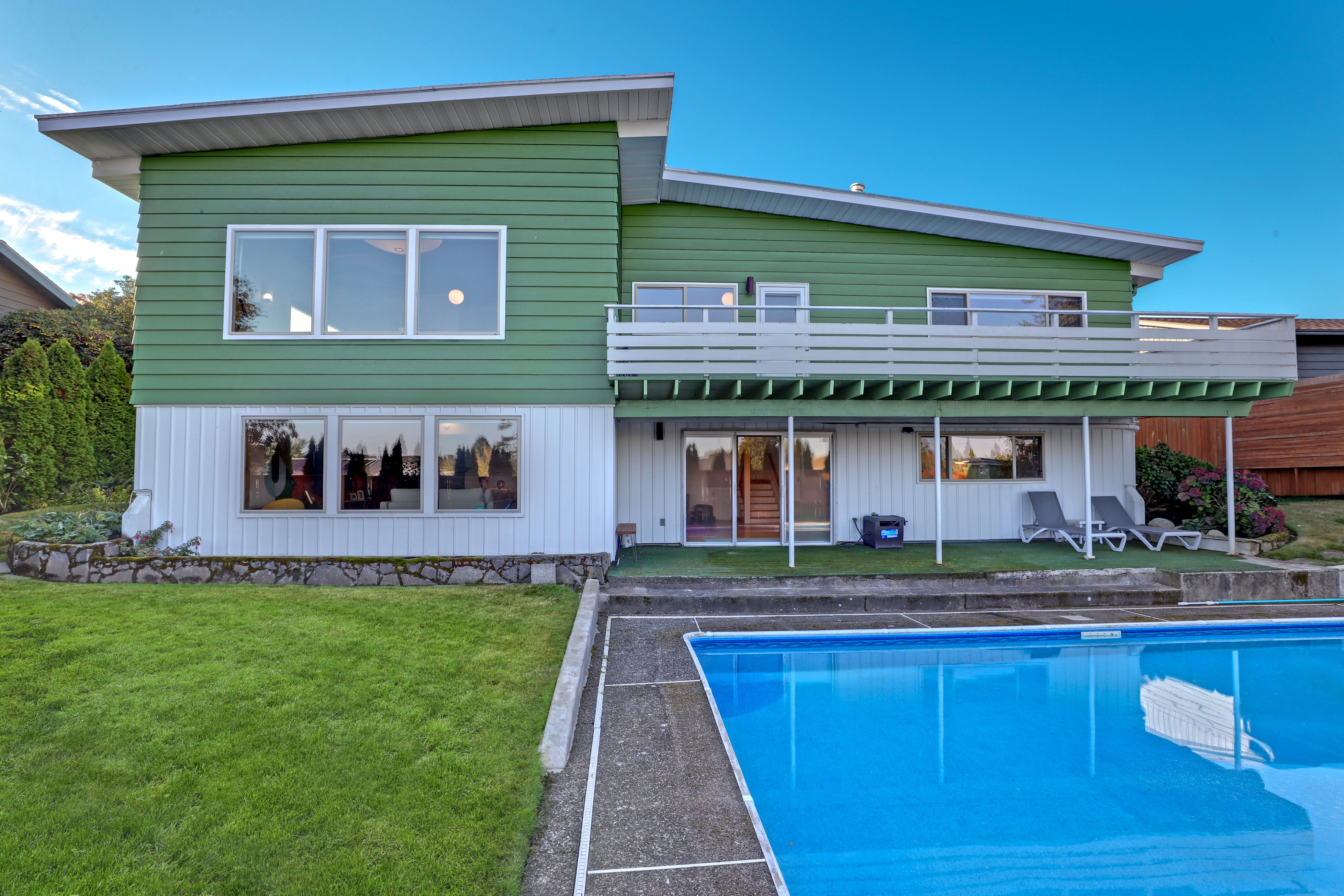The Simpler Life
RELAXING at his dining table and sipping green tea on a gray evening in late May, typically soft-spoken designer Matt Kirkpatrick notes—with more than a hint of incredulity—that the average size of a newly built single-family house in the United States in 2009 was 2,438 square feet. “In 1950,” he says, “it was less than a thousand.” Although Kirkpatrick, 31, was born on the cusp of the bigger-is-always-better 1980s, his own home, nicknamed the Harpoon House, appears to have taken a page from the Leave It to Beaver decade, if only in terms of size.
The first project of his solo company, Design for Occupancy, and a collaboration with his girlfriend, communications designer Katherine Bovee, 30, the Harpoon House has 704 square feet of living space and 448 square feet of unconditioned basement, with three tiers of eco-roof, one bedroom, and one bathroom—no garage. And to leave the smallest possible footprint on their half-size lot (2,500 square feet), the house was built 16 feet wide, 28 feet deep, and 28 feet tall.
For the two young creatives, this über-modern urban tower is a dream home. It’s also the product of both necessity and a desire for economy—of space, of budget, and of impact on the planet. With a budget of $192,700, a smaller home was cheaper to build, says Bovee, “but smaller homes also take less time and money to maintain and naturally require far less electricity and resources.”
To maximize space, the couple chose fixtures and furniture that frequently could serve dual purposes, and carefully curated possessions in which a high-design aesthetic allows them to easily double as art. Every square inch of the property was considered in the design process, always with an eye to usability, efficiency, and an uncluttered look.

Using touch latches and drawer-pulls instead of hardware on FSC-certified cabinets yielded a clean aesthetic and saved money. Bovee and Kirkpatrick then used the leftover cabinet wood to craft the coffee table, dining table, and a side table for the kitchen.
Image: Lincoln Barbour
The yard, for example, augments the home’s limited square footage with a series of “rooms,” including a front garden behind a basalt retaining wall and a sheltered patio made of pervious pavers. (There are plans afoot for a native-plant shade garden, too.) Inside the entryway, a narrow staircase on the right leads down to the diminutive basement, currently used for projects and storage. But up a handful of steps to the left are the living quarters, entering on what is essentially the Harpoon House’s great room, combining kitchen, dining room, and lounging area. The space lives much larger than its 250 square feet with a 10-foot-high ceiling, floor-to-rafters windows, and largely unadorned white walls. The kitchen is a sleek strip of custom cabinets and appliances that were selected for maximum efficiency and minimum noise. The room itself is divided by a vintage sleeper-sofa and a dining table, set back to back. “During the summer, we move the table outside to expand our livable space,” Bovee says, pointing to the tidy deck visible through sliding doors.
When scouting plumbing fixtures during construction, the couple fell in love with the onzen, a western version of a Japanese soaking tub. This singular nod to the spatial hedonism of a larger house—the tub’s four foot-by-four foot proportions dominated the tiny floor plan—pushed Kirkpatrick and Bovee to divine one of the Harpoon House’s most charmingly efficient innovations: a partition wall originally designed to be two and a half feet thick including shelves on both sides was shrunk to one foot thick. “We realized that if we made the wall itself a foot thick,” Kirkpatrick recalls, “we could nest the book shelves and bathroom shelves together inside the wall, saving some pretty valuable floor space.” In addition to the dual-purpose wall, another solution emerged: a dual-flush Caroma toilet-sink combination in which fresh water first used for hand-washing then flows into the cistern for flushing. (To compensate for the system’s “slight awkwardness for things like brushing teeth and shaving,” Kirkpatrick added a larger sink one floor above.)

“We added the desk at the foot of the bed after a boatbuilder who attended our March open house told us it was a common space-maximizing configuration onboard ships,” says Bovee.
Image: Lincoln Barbour
The Harpoon House’s second floor serves as a bedroom, office, and indoor/outdoor den: a sleeping loft contains a double mattress and low desk, while sliding doors open up onto the middle eco-roof, lushly planted with sedum, licorice ferns, coastal strawberries, camas, and creeping thyme. A small patio on the roof, Bovee notes, was “made to fit a table, and nothing more.”
That matter-of-factness rather efficiently sums up the entire home’s design philosophy: build and buy exactly what you need, nothing more. “We’re surrounded by cafés, shops, services, and public outdoor space,” says Bovee. Far from seeing their Lilliputian domain as a retreat, they plan to continue inviting friends and neighbors into their home for events like their seventh annual summer ice cream social, featuring 20 homemade flavors. “There’s no need to have a mini eco-system that’s just for us,” Bovee says. “We want to engage with our community.”




